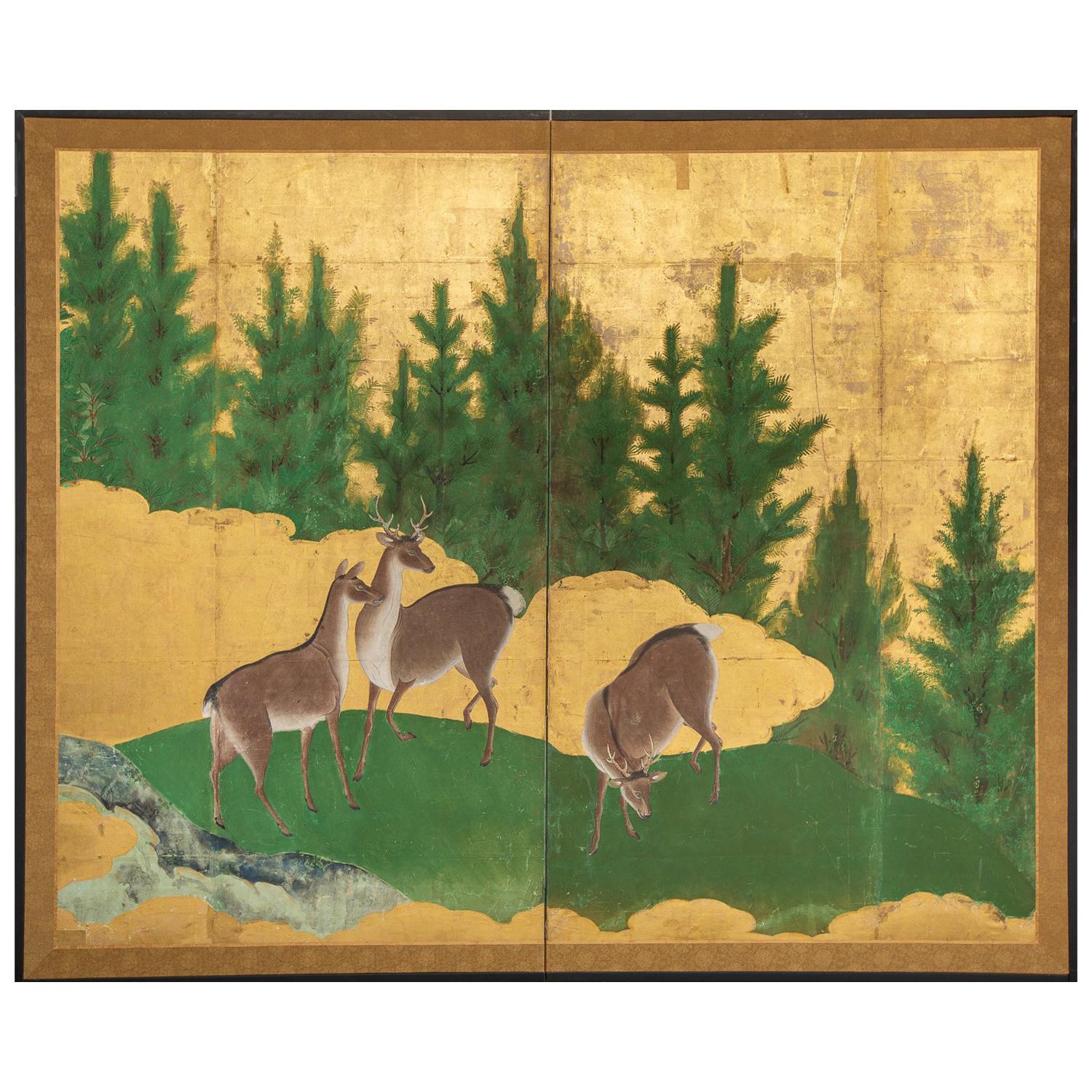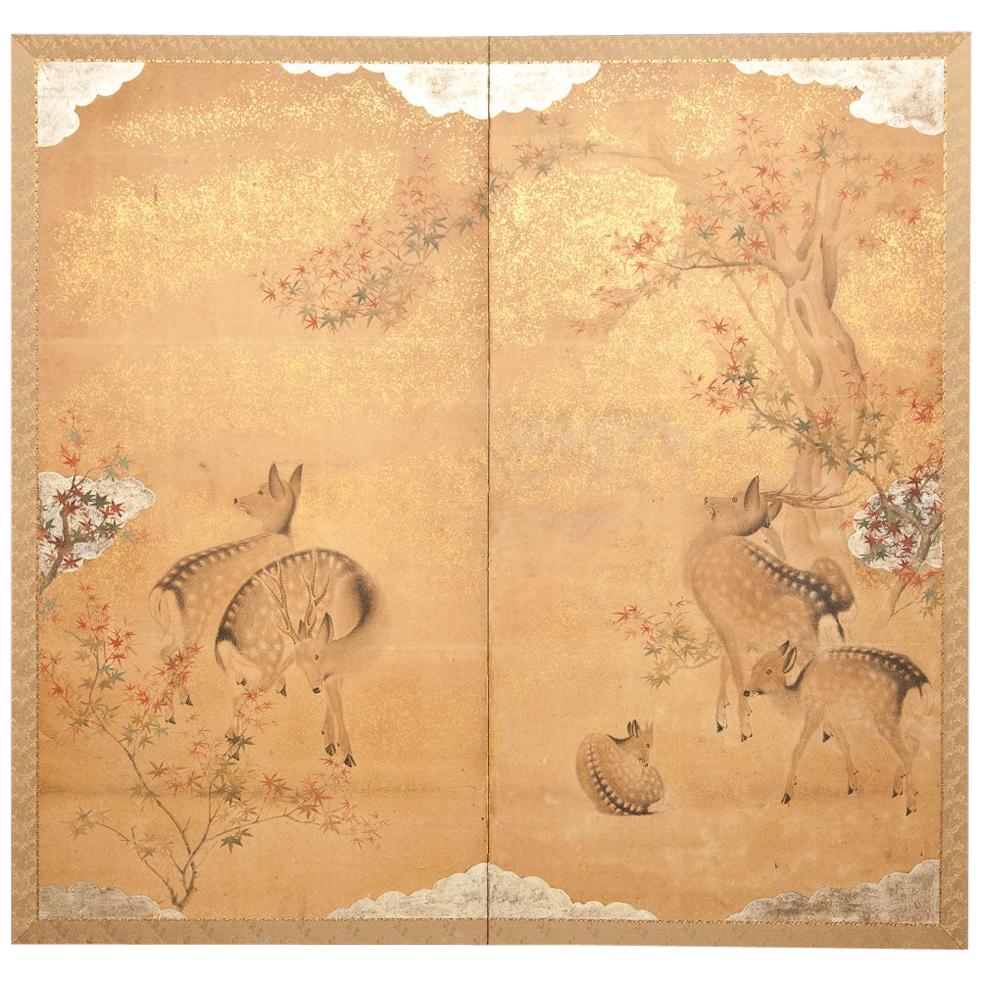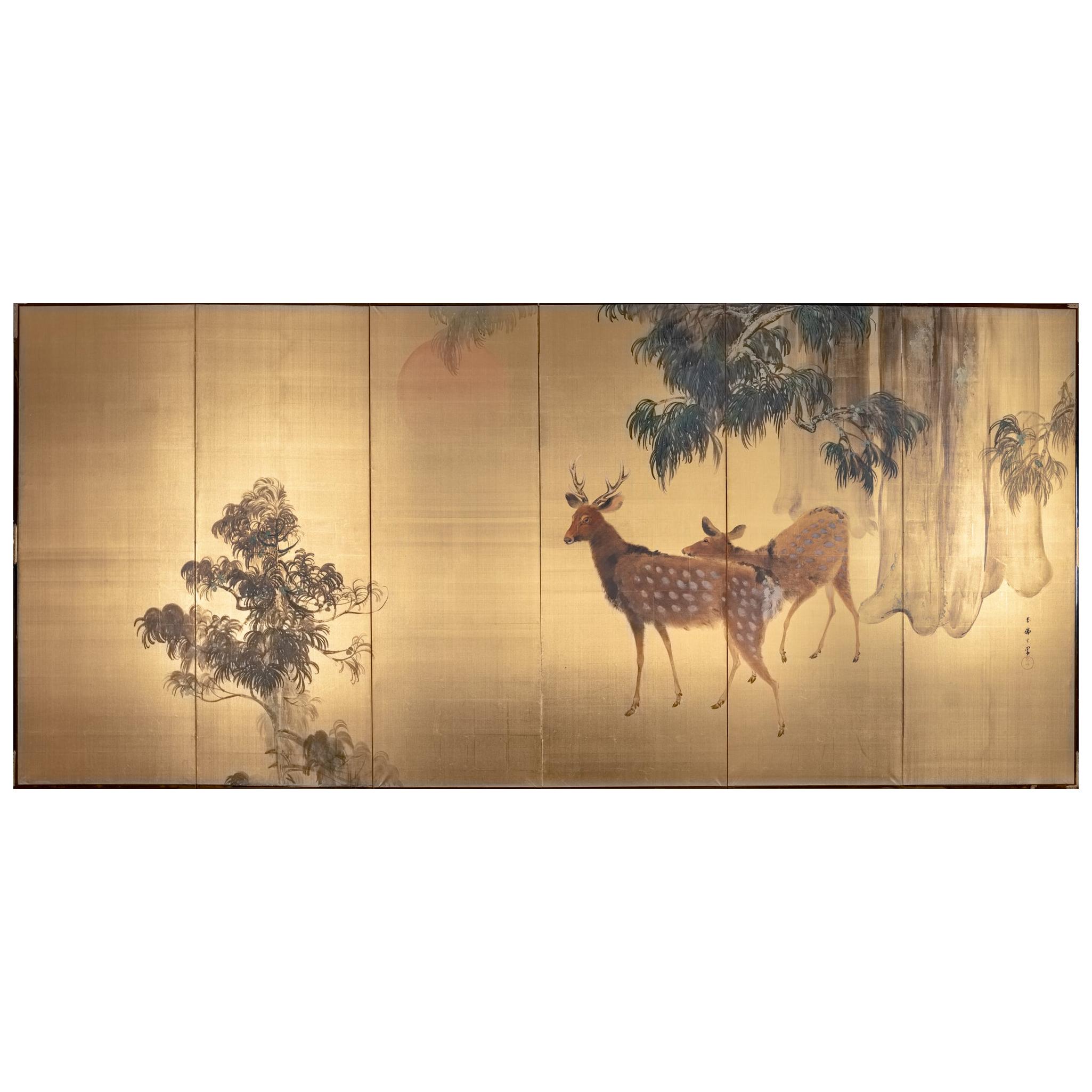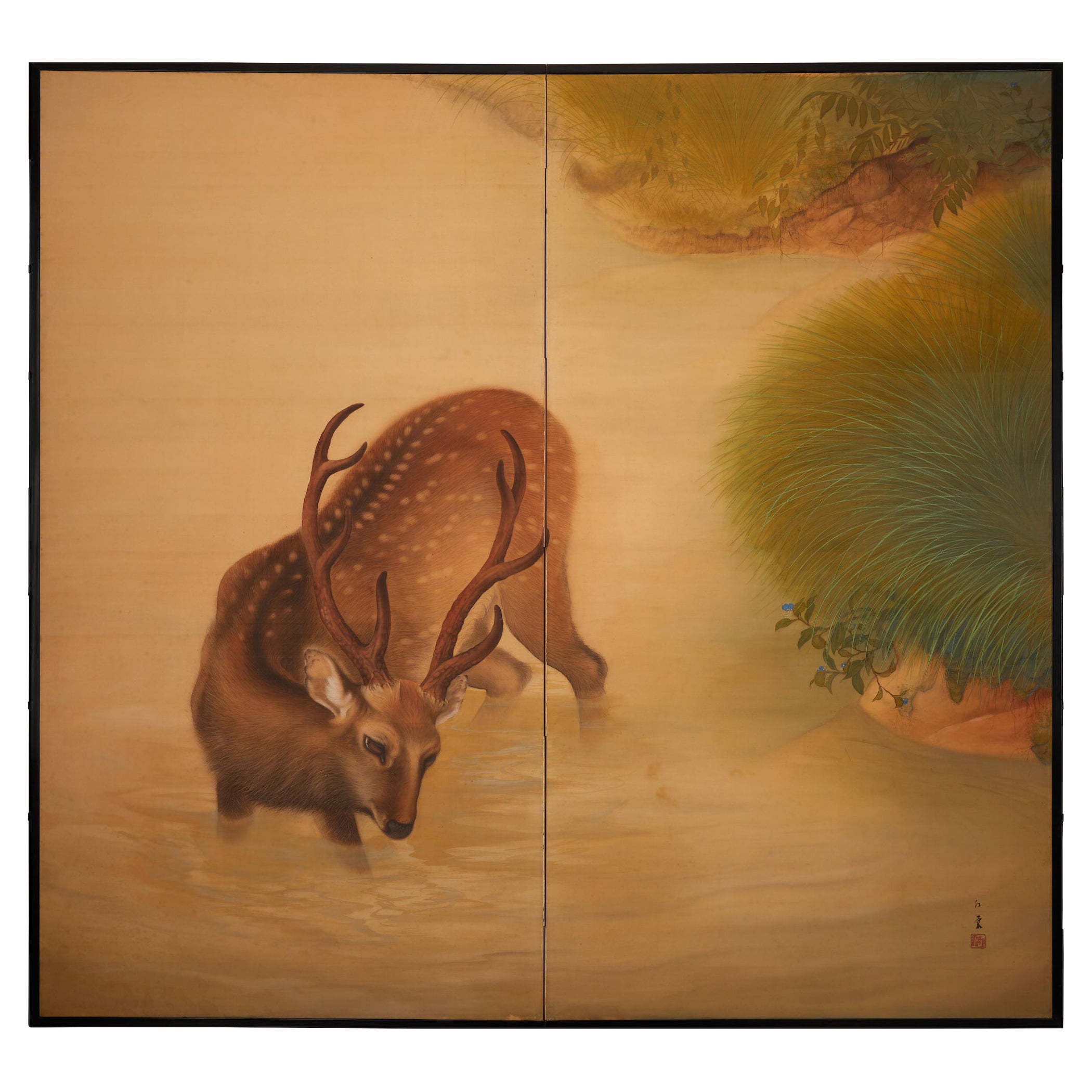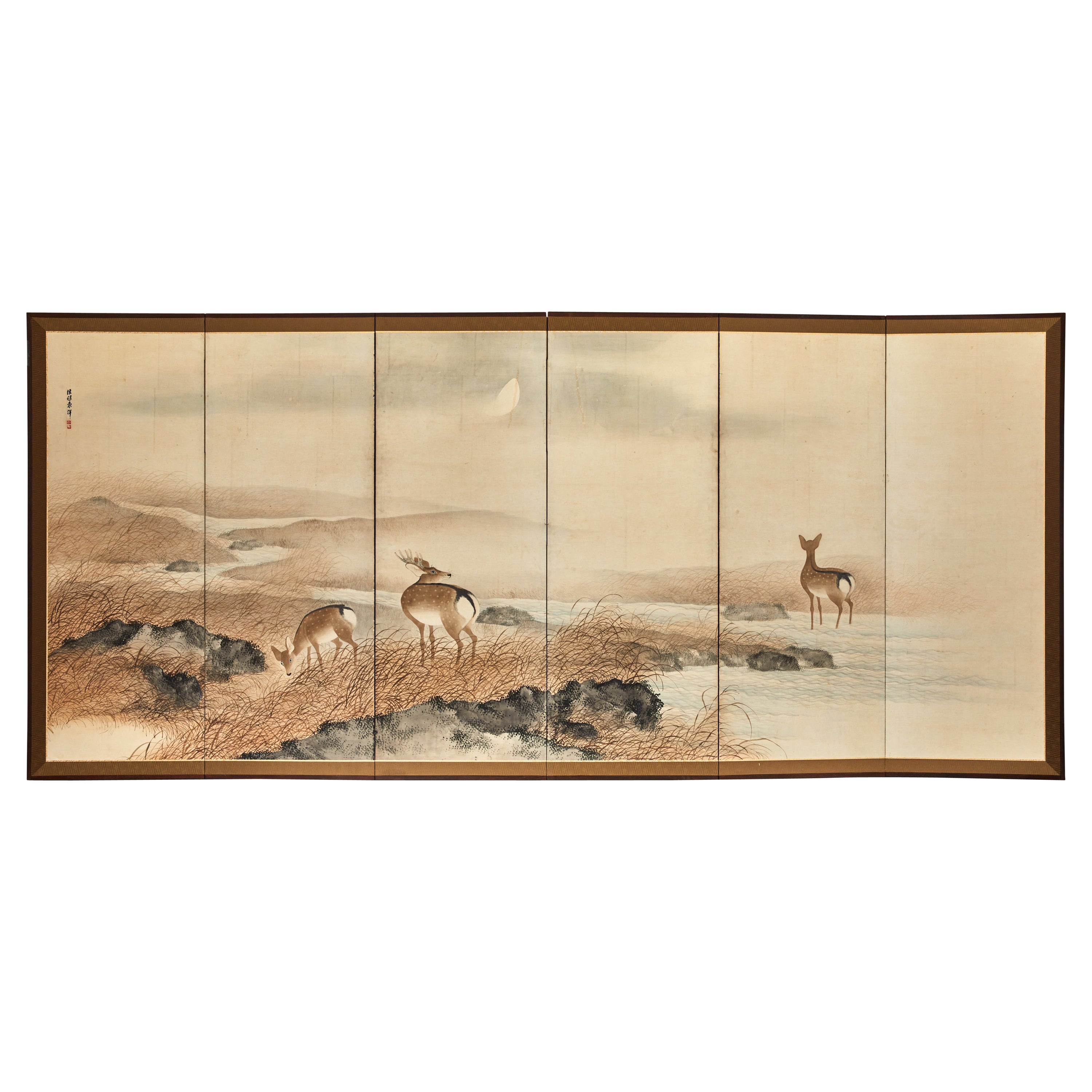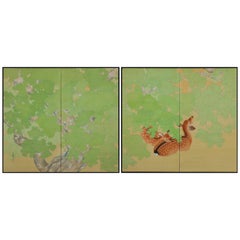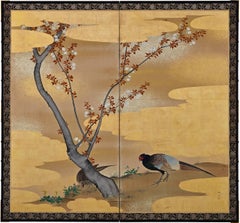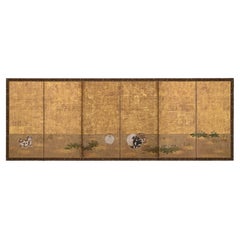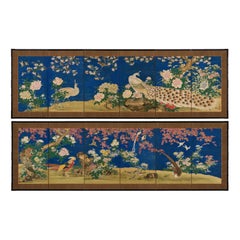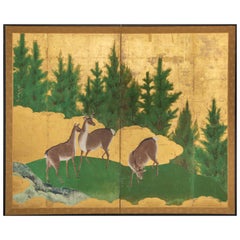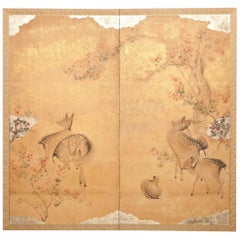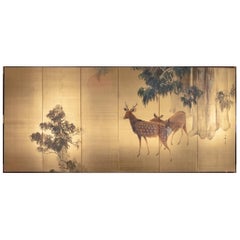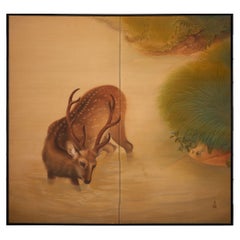Items Similar to 19th Century Japanese Screen, Deer in Spring, Maruyama Shijo School
Want more images or videos?
Request additional images or videos from the seller
1 of 6
19th Century Japanese Screen, Deer in Spring, Maruyama Shijo School
$28,000
£21,261.06
€24,313.61
CA$39,120.06
A$43,510.05
CHF 22,719.59
MX$529,470.98
NOK 290,163.89
SEK 272,122.54
DKK 181,461.81
Shipping
Retrieving quote...The 1stDibs Promise:
Authenticity Guarantee,
Money-Back Guarantee,
24-Hour Cancellation
About the Item
A six-panel Japanese folding screen from the leading Maruyama-Shijo artist Okamoto Toyohiko (1773-1845). Simply featuring three deer and a few sprigs of foliage on a sumptuous gold-leaf background this work emphasizes naturalistic expression and a masterful use of negative space. Reduced to its most basic elements, the blank spaces inspire imagination and evoke the smells, sounds and even the weather of the scene. Whilst deer are traditionally depicted in association with autumn, here the green growth on the tops of the foliage indicates the season of spring. The work references Maruyama Okyo’s two-panel deer screen in the Kyoto National Museum, and is similarly painted in color on gold-leaf. Although famed as a painter of landscapes, Toyohiko seemed particularly fond of and talented at painting naturalistic deer on a large scale. Among the more famous works by him depicting deer are a two-panel screen held at the Mitsui Memorial Museum and a two-fold screen at the Museum of Fine Arts Boston in which Toyohiko depicts a deer and Keibun depicts a pine tree.
Okamoto Toyohiko (1773-1845) was the best pupil of Goshun and through him learned the emotional literary and landscape styles of painting. Toyohiko inherited the naturalist sketching style from Maruyama Okyo. He collaborated with the most senior painting masters of his time and was friendly with the Arisugawa family. Perhaps due to this association he received painting orders from the Imperial court and some of his works remain at the Shugakuin Imperial Villa. After Maruyama Okyo and Goshun founded the Kyoto based Maruyama-Shijo school, Matsumura Keibun and Okamoto Toyohiko successfully continued and secured the lineage. After Goshun’s death they opened their own art school and trained many disciples, among them Shibata Zeshin, Shiokawa Bunrin and Tanaka Nikka.
Works by Okamoto Toyohiko are held in the Kyoto National Museum, British Museum, LACMA, Shizuoka Prefectural Museum of Art, Okayama Prefectural Museum of Art, Osaka City Museum of Art, Boston Museum of Fine Arts, Mitsui Memorial Museum and Shugakuin Imperial Villa.
- Dimensions:Height: 67 in (170.18 cm)Width: 148 in (375.92 cm)Depth: 0.75 in (1.91 cm)
- Style:Edo (Of the Period)
- Materials and Techniques:
- Place of Origin:
- Period:
- Date of Manufacture:Circa 1830
- Condition:Wear consistent with age and use.
- Seller Location:Kyoto, JP
- Reference Number:1stDibs: LU2472334533682
About the Seller
5.0
Recognized Seller
These prestigious sellers are industry leaders and represent the highest echelon for item quality and design.
Established in 2001
1stDibs seller since 2016
70 sales on 1stDibs
Typical response time: 6 hours
- ShippingRetrieving quote...Shipping from: Kyoto, Japan
- Return Policy
Authenticity Guarantee
In the unlikely event there’s an issue with an item’s authenticity, contact us within 1 year for a full refund. DetailsMoney-Back Guarantee
If your item is not as described, is damaged in transit, or does not arrive, contact us within 7 days for a full refund. Details24-Hour Cancellation
You have a 24-hour grace period in which to reconsider your purchase, with no questions asked.Vetted Professional Sellers
Our world-class sellers must adhere to strict standards for service and quality, maintaining the integrity of our listings.Price-Match Guarantee
If you find that a seller listed the same item for a lower price elsewhere, we’ll match it.Trusted Global Delivery
Our best-in-class carrier network provides specialized shipping options worldwide, including custom delivery.More From This Seller
View AllEarly 20th Century Pair of Japanese Folding Screens, Deer Under Maple Trees
Located in Kyoto, JP
Deer under maples
Late Taisho period, circa 1925-1930
Pair of two-panel screens. Ink and pigment on silk.
Signature: Goho
Seal: Goho
A pair of two-fold Japanese silk screens...
Category
Vintage 1920s Japanese Taisho Paintings and Screens
Materials
Wood, Paper, Silk
Early 19th Century Japanese Screen. Cherry Blossom & Pheasants by Mori Tetsuzan
Located in Kyoto, JP
Mori Tetsuzan (1775-1841)
Pheasants and Cherry Blossoms
Two-fold Japanese screen. Ink, color, gofun, gold and silver on paper.
A two-fold Japanese bir...
Category
Antique Early 19th Century Japanese Edo Paintings and Screens
Materials
Gold Leaf
Late 17th Century Japanese Screen. Puppy and Kittens on Gold Leaf.
Located in Kyoto, JP
Anonymous
Late 17th century
Puppy & Kittens
A six-panel Japanese screen. Ink, color, gofun, gold-leaf and gold-fleck on paper.
A medium sized late 17th century Japanese screen fe...
Category
Antique Late 17th Century Japanese Edo Paintings and Screens
Materials
Gold Leaf
Mid 19th Century Japanese Screen Pair. Flowers & Birds of the Four Seasons.
Located in Kyoto, JP
Shioka Sorin (1781-1850)
Flowers & Birds of the Four Seasons
Pair of six-panel Japanese Screens. Ink, gofun and pigments on silk.
Dimensions (each screen): H. 91.5cm x W. 285cm (3...
Category
Antique Mid-19th Century Japanese Edo Paintings and Screens
Materials
Silk
Early 20th Century Japanese Cherry Blossom Screen by Kano Sanrakuki
Located in Kyoto, JP
Cherry Blossoms
Kano Sanrakuki (1898-1981)
Showa period, circa 1930
2-panel Japanese Screen
Color, gofun and gold leaf on paper
Against a backdrop of gold-leafed ground, the lichen covered trunk and branches of the life-sized cherry blossom tree reach out and beyond the confines of the pictorial surface. The overall composition has a feeling of flatness which draws emphasis to the surface and the three-dimensionality of the cherry blossoms. Painstakingly built-up layers of thickly applied shell-white gofun detail the voluminous blossoms and cover large areas of this tour-de-force of Japanese Nihonga painting. By simplifying the background, minimizing the number of colors and depicting the blossoms with such heavy relief, the artist has emphasized the stunning presence of the cherry tree. The type of tree depicted is the Yae-Zakura; a double-layered type of cherry blossom famed for its beauty and strength. When we think of Japanese cherry blossoms, the first thing that comes to mind is Somei Yoshino variety, which has a single flower with five almost white petals. This type is fragile and easily blown away by strong wind or rain. Most of the double-flowered cherry blossoms begin to bloom when the Somei-Yoshino falls, and the flowering period lasts longer than that of the Somei-Yoshino.
Kano Sanrakuki originally studied painting at the Kyoto City Arts and Crafts School under the tutelage of Yamamoto Shunkyo...
Category
Early 20th Century Japanese Showa Paintings and Screens
Materials
Gold Leaf
18th Century Japanese Screen Pair. Plum & Young Pines. Kano School.
Located in Kyoto, JP
Dimensions (Each screen): H. 176 cm x W. 378 cm (69’’ x 149’’)
This pair of Japanese folding screens depict blossoming plum trees amongst young pines. They are designed to capture t...
Category
Antique Late 18th Century Japanese Edo Paintings and Screens
Materials
Gold Leaf
You May Also Like
Japanese Two-Panel Screen, Deer in Cedar Landscape
Located in Hudson, NY
Originally fusuma doors, three deer stand in a clearing in a pine forest with gold leaf mist. Mid Edo period painting in mineral pigments on gold leaf wi...
Category
Antique 18th Century Japanese Edo Paintings and Screens
Materials
Gold
Japanese Two Panel Screen Nara Deer in Gentle Yoshino Landscape
Located in Hudson, NY
Japanese two panel screen: Nara Deer in Gentle Yoshino Landscape. Yoshino is in the Nara Prefecture, an area famous for these small and tame deer native to J...
Category
Antique Early 1900s Japanese Meiji Paintings and Screens
Materials
Gold Leaf, Silver Leaf
Japanese Six-Panel Screen Buck and Doe at Dawn
Located in Hudson, NY
Japanese six-panel screen: Buck and doe at dawn. Showa period (1926-1989) painting of a rising sun seen through a woodland scene with a pair of deer. In Japan, deer are thought to be...
Category
Early 20th Century Japanese Showa Paintings and Screens
Materials
Bronze
Japanese Two-Panel Screen, Wading Deer
Located in Hudson, NY
In Japan, it is a Shinto belief that the deer is a treasured and sacred animal. This admirable scene captures this gentle creature in its natural habitat with beautiful detail in bot...
Category
Early 20th Century Japanese Paintings and Screens
Materials
Silk, Lacquer
Japanese Six Panel Screen: Deer in Moonlit Water Landscape
Located in Hudson, NY
Meiji period (1868 - 1912) painting of a family of deer exploring the grassy and rocky shoreline of a meandering creek under the moonlight. Shijo School ink painting with minimal pi...
Category
Antique 19th Century Japanese Paintings and Screens
Materials
Brocade, Silk, Paper
Antique 19th Century Japanese Two-Panel Screen ‘Byobu’, Kano School, Edo Period
Located in London, GB
Japanese Kano School Edo period two-panel screen depicting flowering prunus and bamboo on a rock formation, with colorful birds next to a body of water. ...
Category
Antique Mid-19th Century Japanese Edo Paintings and Screens
Materials
Gold Leaf
More Ways To Browse
Antique Furniture Springs
Gold Deer
Japanese Folding Screen Screen
Japanese Folding Screens
Gold Folding Screen
Japanese Folding Screen Art
Asian Screens Green
Japanese Screen Tree
Japanese Screen Kyoto
Green Japanese Screen
Edo Screen Gold
Antique Asian Folding Screen
Deer Panel
Kyoto Screens
Antique Deer Painting
Folding Screen Gold Leaf
Japanese Screen Gold Landscape
Two Panel Folding Screen
